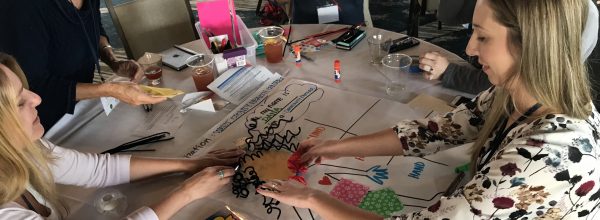If you read my colleague Susannah Brouwer’s piece “Navigating the Hiring Craze,” you know that CCI has been on a recruiting and hiring spree. To get our new hires up to speed on the state of the safety net system, we compiled some articles and resources for them. I suggested “Social Justice and Community Health Centers: Commitment to One Gave Rise to the Other” which gives a good overview of Dr. Jack Geiger’s involvement in the development of the community health center movement in the United States. For me, it is important to understand the origins and history of the safety net to best make suggestions for improvement and care delivery transformation.
I’ve also been thinking about that history in the context of a new program that CCI launched at our SNIN meeting last month. Roles Outside Of Traditional Systems (ROOTS) is a year-long learning collaborative that provides a route for clinics to apply their assets, expertise, and credibility to the challenge of creating environments that support health and equity. The program includes online and in-person sessions, technical assistance, site visits, and support for a social determinants of health (SDOH) project that is a clinic and community priority.

We chose this program name for two reasons. First, as a reminder that safety net clinics have played a longstanding role in addressing SDOH. The article about Dr. Geiger discusses how he wrote prescriptions for food for patients, and also had health center staff involved in repairing housing, digging wells, and creating a 500-acre cooperative farm to grow vegetables—all the way back in Mississippi in the 1960s.
One of the “a-ha” moments he reportedly experienced that led him to connect medicine with social conditions occurred while standing on top of a building at his medical school at Case Western Reserve University, looking over the city of Cleveland. At that moment, thinking about the connection (or lack thereof) between the medical resources at the University and the poverty and social conditions in the city surrounding it, he thought: “Why not make medicine an instrument of social change?” The foundation and history of safety net clinics is grounded in understanding the root causes of poor health, and in going beyond the four walls of a clinic to address those causes.
Second, we choose the name ROOTS to reinforce one of the main objectives of the program: to clarify the role of clinicians and other team members in addressing SDOH. What is the most appropriate role that a clinic can play, and what should be left to other community-based organizations? Beyond siloed interventions like community gardens or promotora programs, what else can clinics do to weave addressing SDOH into the fabric of their organizations, beyond one-time, grant-funded initiatives?
My interests and experiences in health care stem from two grassroots, community-led health projects: The Berkeley Free Clinic and The Shanti Project. Both organizations emerged at a time when people were demanding access to and autonomy over their health care, as well as more patient-centered care. Both organizations also stressed the importance of relationships, human connection, and addressing social needs outside of the medical model to promote healing and wellness at the individual and community level. As we launch our ROOTS program, I am excited to pull from past models—and push the current boundaries of the health center model to address upstream factors and the medical, behavioral, and social needs impacting health.
Find this useful or interesting? We’re constantly sharing stuff like this. Sign up to receive our newsletter to stay in the loop.




